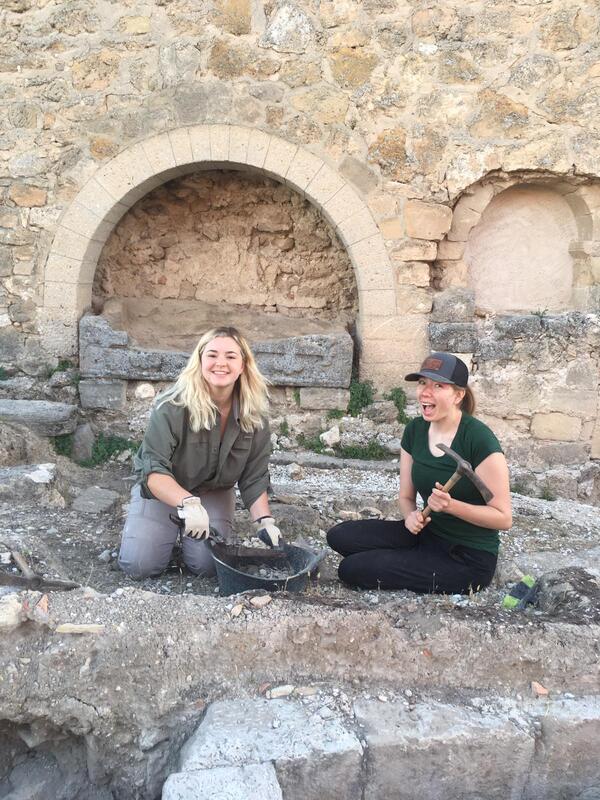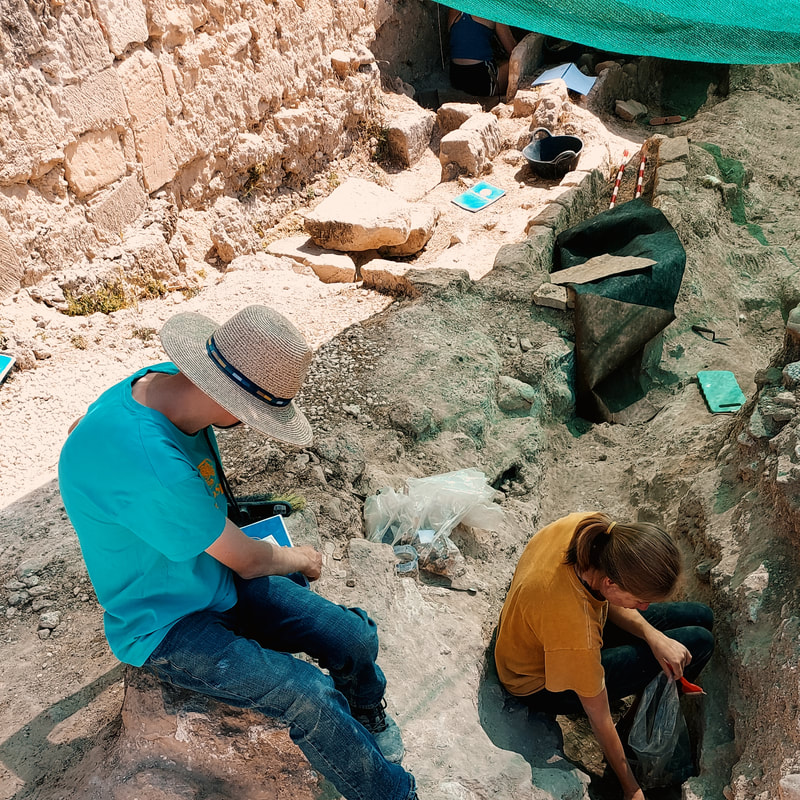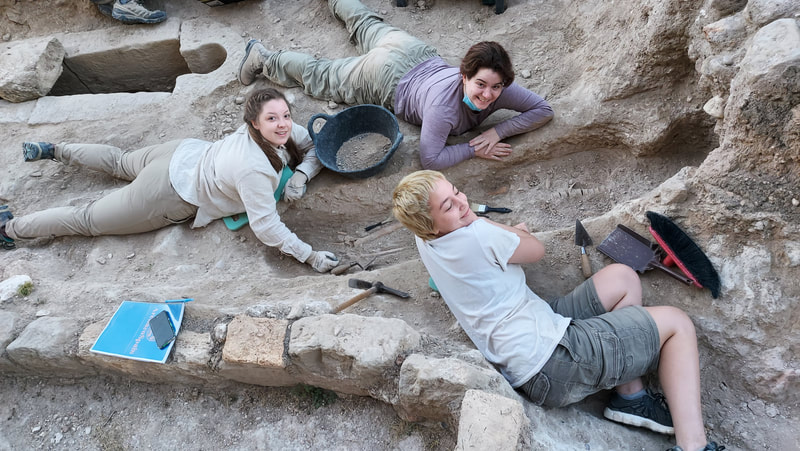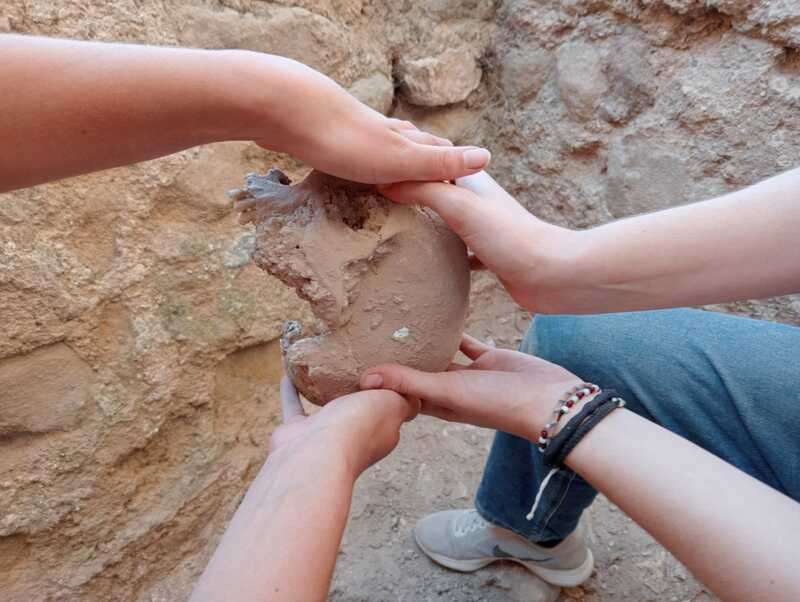|
|

The Castle History.
Between the 9th and 13th centuries, Zorita Castle thrived as a focal point for commerce and military adventures during the wars to take control of Spain between Muslim and Christian armies. Since then, the castle has fallen into obscurity. Geographically unpopular, ignored by academia, and until recently left to crumble. Today the former headquarters of one of Spain's most important military orders is coming back to life. Since 2014 and overseen by the Heritage Office of the regional Castilla-La Mancha government, Zorita Castle field school teaches students and archaeology lovers from around the world how to conduct an archaeological excavation while uncovering part of the castle history. The best preserved building inside the castle is the church of San Benito. The knights of the order of Calatrava built the church at the end of the 12th century when the castle became the order's headquarters. Documents mention a cemetery, but the only material evidence was a long stone slab, possibly a burial cover. When cleaning the stone, a Medieval Tic-Tac-Toe, a game we owe to the Arabs was discovered. Throughout the fifteenth century and like other castles, Zorita was no longer the residence of Commanders of Calatrava Cavalry Order, whose preferred live in houses in nearby towns like Pastrana, becoming an arsenal castle, guarding firearms, propulsion, armor, ammunition and miscellaneous tools. 
The Order of Calatrava and Zorita Castle The Order of Calatrava was born in the actual region of Castilla-La Mancha, specifically in the province of Ciudad Real, where during the twelfth century intensified the struggle between the Berber villages arrived in Al-Andalus and the Christian of Castille. All Mancha region south of Almagro is known today as Campo de Calatrava, the first seat of the institution of monks warriors. Alarcos, defeating in July 19th of 1195, saw the fall of the Guadiana frontier, with the loss of the Head Castle of the Order (Old Clatrava castle). This battle and abandonment of Salvatierra means an unprecedented crisis that brought the Order to the brink of extinction. The remains of the Order took refuge in Zorita castle, one of the few possessions that kept the calatravos under their control. In Zorita, the Order was again organized, rearmed and once strengthened was delivered to new strategies for the recovery and control of territory. After the Christian victory in the battle of Las Navas de Tolosa against the Almohad in 1212, the Order settled permanently based in New Calatrava castle, construction designed to support a large-scale siege avoid Alarcos surprises like.
| ||||||||||||||||||||||||
|
2. The study of the bones
The second week will be dedicated to the study of the human remains discovered at Zorita Castle. After packaging, the bones will be transported to the laboratory where the inventory of each skeleton will be carried out as well as the preparation of the registration forms for each tomb. For the photographic record of the human remains, the reconstruction of the skeleton will be necessary. This process will allow obtaining a first evaluation of the body. Later, the bones will be studied in detail and marks and pathologies will be analyzed. Workshop on osteology Introduction to osteology: the human skeleton Anthropometry. Systematic measurements of standard parameters Determination of size and sex Determination of age of death Health of the population: degenerative diseases, deficiency diseases, infectious diseases, traumatic pathologies. |
History Lectures
Zorita castle History
The Calatrava Military Order
Archaeology in Zorita castle
Daily Schedule
6,30h Breakfast
07-10,30h Excavation
10,30-11,00h Snack break
13,30-14,30h Free time
14,30h Lunch
15,30h “Siesta”
18,00-20,00h Laboratory/Lectures/Afternoon excursions
Weekend excursions
Toledo World Inheritage Town
Visigothic site of Recopolis
Zorita castle History
The Calatrava Military Order
Archaeology in Zorita castle
Daily Schedule
6,30h Breakfast
07-10,30h Excavation
10,30-11,00h Snack break
13,30-14,30h Free time
14,30h Lunch
15,30h “Siesta”
18,00-20,00h Laboratory/Lectures/Afternoon excursions
Weekend excursions
Toledo World Inheritage Town
Visigothic site of Recopolis
accommodation
On the first week the group, including ArchaeoSpain staff, will be staying at Posada de Zorita Guest House, just five-minute walk down from the castle. The students will be sharing double-triple rooms with bathroom and air conditioning.
Meals, with a fixed menu, will be provided at the Posada where we are fortunate to have a good coock, who works hard to make us feel like at home wile enjoyong a wide diversity of spanish traditional dishes.
During the second week the group will reside in the Jardín de San Bartolomé, archaeological headquarter of Archaeospain. It is an old house with a large garden and other spaces used as laboratories, where the registration and study of the bone remains will be carried out.
Meals, with a fixed menu, will be provided at the Posada where we are fortunate to have a good coock, who works hard to make us feel like at home wile enjoyong a wide diversity of spanish traditional dishes.
During the second week the group will reside in the Jardín de San Bartolomé, archaeological headquarter of Archaeospain. It is an old house with a large garden and other spaces used as laboratories, where the registration and study of the bone remains will be carried out.
dates & fees
Program dates for 2024 FULL
Program Fees:
Fees Include:
• Full Room and Board
• Fieldwork training
• Seminars and workshops
• Excursions and other activities
• Medical Insurance
• Transportation to and from airport
• Application fee
• Administrative costs
Part of your fee will go towards the research project.
Fees DO NOT include airfare
PAYMENT PROCESS:
To reserve a space, you must pay a $400 application deposit. (Included in the price of the program).
The remainder of the program cost will be due by April 15th.
Application fees will be refunded if the applicant is not selected.
Application Deadline:
Rolling application. We accept applications until all spaces are filled.
Cancellation and Refund Policy:
• Before March 1st: All payments, except for $100 from the application deposit, are refundable.
•Between March 1st and April 1st: Application fee non-refundable. The remaining balance is refundable.
• After April 1st: All payments are non-refundable unless your application is rejected by the program director.
Program Fees:
Fees Include:
• Full Room and Board
• Fieldwork training
• Seminars and workshops
• Excursions and other activities
• Medical Insurance
• Transportation to and from airport
• Application fee
• Administrative costs
Part of your fee will go towards the research project.
Fees DO NOT include airfare
PAYMENT PROCESS:
To reserve a space, you must pay a $400 application deposit. (Included in the price of the program).
The remainder of the program cost will be due by April 15th.
Application fees will be refunded if the applicant is not selected.
Application Deadline:
Rolling application. We accept applications until all spaces are filled.
Cancellation and Refund Policy:
• Before March 1st: All payments, except for $100 from the application deposit, are refundable.
•Between March 1st and April 1st: Application fee non-refundable. The remaining balance is refundable.
• After April 1st: All payments are non-refundable unless your application is rejected by the program director.
Travel Arrangements:
You should begin making travel plans as soon as your place in the group is reserved, and you should complete them upon being notified of your selection. We strongly recommend that participants purchase travel insurance to cover all needs including medical, accident, baggage loss, delays and personal liability. ArchaeoSpain is not a travel provider nor is a registered travel agent. Your travel arrangements to and from Spain are subject to the terms and conditions of your travel agency. In the rare event that the program is cancelled, ArchaeoSpain will refund program fees, but is not responsible for non-refundable airline or other tickets or payments or any similar penalties that may be incurred. It is your responsibility to protect yourself against airline and travel agency cancellation fees.
Medical Insurance:
All ArchaeoSpain participants at Zorita Castle are covered with an insurance packet that provides medical and surgical treatment and prescription drugs in case of accident or sudden illness. This insurance also provides some compensation for baggage loss or theft. With your program packet we will send you more details regarding this coverage, but you may contact our staff for more information.
European students should bring an EHIC card with them.
You should begin making travel plans as soon as your place in the group is reserved, and you should complete them upon being notified of your selection. We strongly recommend that participants purchase travel insurance to cover all needs including medical, accident, baggage loss, delays and personal liability. ArchaeoSpain is not a travel provider nor is a registered travel agent. Your travel arrangements to and from Spain are subject to the terms and conditions of your travel agency. In the rare event that the program is cancelled, ArchaeoSpain will refund program fees, but is not responsible for non-refundable airline or other tickets or payments or any similar penalties that may be incurred. It is your responsibility to protect yourself against airline and travel agency cancellation fees.
Medical Insurance:
All ArchaeoSpain participants at Zorita Castle are covered with an insurance packet that provides medical and surgical treatment and prescription drugs in case of accident or sudden illness. This insurance also provides some compensation for baggage loss or theft. With your program packet we will send you more details regarding this coverage, but you may contact our staff for more information.
European students should bring an EHIC card with them.
Right of Refusal:
ArchaeoSpain reserves the right to refuse an applicant’s selection. This is a rare occurrence and is most likely due to a person’s inability to meet health requirements or in the interest of group compatibility. Once in the field, the program director and ArchaeoSpain reserve the right to send a student away from the program should that person’s behaviour compromise the safety, research objectives and general performance of the group, or violate Spanish laws, regulations or customs.
ArchaeoSpain reserves the right to refuse an applicant’s selection. This is a rare occurrence and is most likely due to a person’s inability to meet health requirements or in the interest of group compatibility. Once in the field, the program director and ArchaeoSpain reserve the right to send a student away from the program should that person’s behaviour compromise the safety, research objectives and general performance of the group, or violate Spanish laws, regulations or customs.
the staff
SITE DIRECTORS:
|
Dionisio Urbina Martínez
PhD. in Geography and History from the University Complutense of Madrid. He has been a professional archaeologist since 1990 and has directed over fifty archaeological excavations: Medieval, Late Antique, Roman, Iron and Bronze Age. Specialist in the Roman world and the Second Iron Age in the center of the Iberian Peninsula, he has published several scientific articles and divulgative books, co-edited several conferences and exhibition catalogs, and several articles in scientific journals. He has taught numerous courses, conducted ten archaeological exhibitions as well as various presentations, and lectures and seminars. He taught the specialized course “Generalist in Antiques and Twentieth Century”, at the Center for Arts and Business Álvaro Durán, from 2001 to 2007, and was a teacher of the Degree in Cultural Management at the University Antonio de Nebrija in 2009 and 2010. Currently runs Achaeospain, directing the investigations at the sites of Zorita Castle and Cerro de la Muela Roman castellum. |
|
Víctor Barrera Alarcón.
Graduate in History and Archaeology from the Complutense University of Madrid and Master in Physical Anthropology: Human Evolution and Biodiversity by the Complutense University of Madrid, the University of Alcalá de Henares and the Autonomous University of Madrid. Specialist in Archaeology and Forensic Anthropology by the Institute of Professional Training in Forensic Sciences of Madrid. I have collaborated as a technician in archaeology and as a specialist in human skeletal remains in more than a dozen archaeological excavations both in Spain (Convento de San Juan de Dios, Arco de Conejeros, Ermita de la Vega, el Ceremeño, Zorita de los Canes) and abroad (Hala Sultan Tekke -Cyprus- and Viminacium -Serbia-). I have directed the Osteoarchaeology Laboratory of the Complutense University of Madrid for four years and carried out the osteological studies of 5 different collections during those years. I have also taught several introductory courses on osteoarchaeology for young archaeologists during my tenure there. I have more than a dozen scientific publications including articles, book chapters and conference proceedings. |
If you are part of one of Archaeospain's programs, you agree to respect the archaeological sites and monuments in accordance with the laws of each country, and to accept the code of ethics that does not allow taking photographs of the archaeological sites or of the discoveries made in them. The publication of photographs related to the sites and their findings, especially on social media, requires always the prior approval of the directors of the archaeological sites.
excursions
You will be inmersed in a research project and live in a different country for some weeks. On the weekend excursions you will have the opportunity to meet different aspects of the Spanish culture and traditions, visiting historical cities, picturesque villages and archaeological sites.
Whole day excursions:
Toledo, declared World Heritage City, is a very unique place. It is known as the city of the three cultures: Muslim, Christian and Jewish. You will have the opportunity to visit some examples like the mosque of the Cristo de la Luz, the synagogue of The Tránsito or the Cathedral of Toledo. We’ll get lost in its narrow streets, have tapas at its terraces and we will also have time for some shopping.
Whole day excursions:
Toledo, declared World Heritage City, is a very unique place. It is known as the city of the three cultures: Muslim, Christian and Jewish. You will have the opportunity to visit some examples like the mosque of the Cristo de la Luz, the synagogue of The Tránsito or the Cathedral of Toledo. We’ll get lost in its narrow streets, have tapas at its terraces and we will also have time for some shopping.
Afternoon excursion
Recópolis. La única ciudad visigoda conservada en España, se halla a una milla del castillo. Vistaremos sus ruinas y el centro de interpretación para conocer cómo era la zona antes de la existencia del castillo.
Recópolis. La única ciudad visigoda conservada en España, se halla a una milla del castillo. Vistaremos sus ruinas y el centro de interpretación para conocer cómo era la zona antes de la existencia del castillo.
photo archive
survivors' tales"This being my first dig, the ninth of July was just like any other day on the site, exciting and fascinating. As always, the walk up to Zorita Castle was filled with beautiful views, but the site was where the real finds were waiting. After brushing and excavating the walls, the team started in on the floor. Working on the southern end of the room was tough going, the soil was quite compact with a sandy brown coloring.
A white, smooth stone had revealed itself and shone differently than all the usual finds. I picked it up and approached the director of the site. Immediately his face lit up and as he showed it to the other director she let out a squeal. As they explained to me that I had stumbled upon an ax head from the Neolithic age I could not quite believe it. I had held something thousands of years old and it had survived those many years to tell its story". - Sydney Comstock, 2014 "Today we began by excavating around the house-shaped structure. I was digging in the stratigraphic unity 104. My goal was to bring down the level of SU 104 enough to see if the two flanking walls had an end point. This question has not yet been answered, as the trench is not deep enough to tell. Unity 104 has gray-white colored soil that is very light, sandy, and extremely dry. We have found many bone and pottery fragments along with some iron and glass in this unity as well. All of the bone fragments are presumably animal because most recognizable ones belonged to a sheep or goat. The pottery ranges in color from white, to green-blue, to black. Many of the pieces are without decoration, but some have geometric patters painted or stamped on." - Katherine Hodge, 2015 "Today, July 10th, is the tenth day of our three-week-long excavation of the Castillo de Zorita de los Canes in Guadalajara, Spain. We will continue to excavate to find out if, in-fact, this was a rubbish pit, for whom it was one, and what all was thrown away. The objects inside this unity may tell us who used this pit, what the people of the castle ate, what they used as vessels, and what they burned to cook or fuel a flame with (charcoal). The structure next to the rubbish pit is thought to be a room for a castle prior or priest; this might also help us understand what this corner was used for". - Madison Taylor, 2014 |
























































